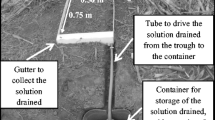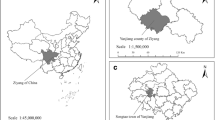Abstract
Plant cover modifies the physicochemical properties of the soil surface, which results in an enrichment in organic matter and a greater infiltration. So, this study was conducted to determine if its establishment in olive groves was effective, compared to conventional tillage, for the reduction in pollution by soluble phosphorus (P). Surface runoff, soluble P and Olsen P losses in sediment were analyzed in three experiment fields of ecological olive trees in the province of Córdoba (Spain), from 1 June 2003 to 1 June 2005. The cover system reduced the total losses of both variables in the three plots (between 7.6% and 36.5% the dissolved P loss and between 16.3% and 56.4% that of the runoff), with a certain parallelism being observed in the time distribution of the losses in both soil management systems, with significant Spearman coefficients of correlation, ranging between 0.60 and 0.98. Over half the losses of the runoff and dissolved P were produced in two or three events for the two management systems. The establishment of plant cover altered the relative composition in the Olsen P loss (raising the proportion of soluble P) and usually increased the dissolved P rate. Finally, and although it is a positive technique and highly recommendable in the area’s olive groves, it was not completely effective in controlling water pollution in relation to the soluble P concentration, since this was over 0.11 mg l−1 in all the cases with a cover.












Similar content being viewed by others
Abbreviations
- TDP:
-
total dissolved P
- DRP:
-
dissolved reactive P (RP<0.45 μm)
- CT:
-
conventional tillage
- PC:
-
plant cover
- CV:
-
coefficient of variation
References
Agrela, F. (2003). Evaluación manual y automatizada de la cubierta de restos de cosecha en sistemas de Agricultura de Conservación. Tesis Doctoral, Departamento de Ingeniería Rural, Universidad de Córdoba.
Angle, J. S., McClung, G., McIntosh, M. C., Thomas, P. M., & Wolf, D. C. (1984). Nutrient losses in runoff from conventional and no-till corn watersheds. Journal of Environmental Quality, 13, 431–435.
Australia and New Zealand Environment and Conservation Council (2000). Australian and New Zealand guidelines for fresh and marine water quality (National Water Quality Management Strategy Paper 4). Canberra, ACT: ANZECC.
Bremner, J. M. (1965). Inorganic forms of nitrogen. In C. A. Black, et al. (Eds.), Methods of soil analysis, Part 2. Agronomy, 9, 1179–1237. Madison, WI: American Society of Agronomy, Inc.
Carignan, R., & Kalff, J. (1980). Phosphorus sources for aquatic weeds: Water or sediments. Science, 207, 987–989.
Catt, J. A., Howse, K. R., Farina, R., Brockie, D., Todd, A., Chambers, B. J., et al. (1998). Phosphorus losses from arable land. Soil Use and Management, 14, 168–174.
Correll, D. L., Jordan, T., & Weller, D. E. (1999). Effects of precipitation and air temperature on phosphorus fluxes from Rhode river watersheds. Journal of Environmental Quality, 28, 144–154.
Daniel, T. C., Sharpley, A. N., Edwards, D. R., Wedepohl, R., & Lemunyon, J. L. (1994). Minimizing surface water eutrophication from agriculture by phosphorus management. Journal of Soil and Water Conservation, 49(Suppl. 2), 30–38.
Davenport, T. E. (1994). EPA’s perspective – You need to protect water quality. Journal of Soil and Water Conservation, (Spec. Suppl). 49(2), 14–15.
Daverede, I. C., Kravchenko, A. N., Hoeft, R. G., Nafziger, E. D., Bullock, D. G., & Warren, J. J. (2003). Phosphorus runoff: Effect of tillage and soil phosphorus levels. Journal of Environmental Quality, 32, 1436–1444.
Díaz, I. (2002). Caracterización de la liberación de fosfatos en suelos representativos del área mediterránea. Trabajo Profesional de Fin de Carrera, Departamento de Ciencias y Recursos Agrícolas y Forestales, Universidad de Córdoba.
Dillaha, T. A., Reneau, R. B., Mostaghimi, S., & Lee, D. (1989). Vegetative filter strips for agricultural nonpoint source pollution control. Transactions of the ASAE, 32(2), 513–519.
Douglas, C. L., King, K. A., & Zuzel, J. F. (1998). Nitrogen and phosphorus in surface runoff and sediment from a wheat–pea rotation in Northeastern Oregon. Journal of Environmental Quality, 27, 1170–1177.
European Environment Agency (1998). Europe’s environment: The second assessment. Copenhagen, Denmark: European Environment Agency.
Fernández-Escobar, R. (2004). Fertilización. In D. Barranco, R. Fernández-Escobar, & L. Rallo (Eds.), El cutivo del olivo. Madrid: Mundi-Prensa.
Francia, J. R., Martínez, A., & Ruiz, S. (2000). Erosión en suelos de olivar en fuertes pendientes. Comportamiento de distintos manejos de suelo. Edafología, 7, 147–155.
Giráldez, J. V. (1998). Efecto de los sistemas de laboreo sobre las propiedades físicas del suelo. In L. García & P. González (Eds.), Agricultura de Conservación. Fundamentos agronómicos, medioambientales y económicos. (pp 13–40). Córdoba: Asociación Española de Laboreo de Conservación.
González, P., & Ordóñez, R. (1998). Efecto del laboreo sobre la materia orgánica y la fertilidad de los suelos. In L. García & P. González (Eds.), Agricultura de Conservación. Fundamentos agronómicos, medioambientales y económicos. (pp 41–50). Córdoba: Asociación Española de Laboreo de Conservación.
Hart, M. R., Quin, B. F., & Nguyen, M. L. (2004). Phosphorus runoff from agricultural land and direct fertilizer effects: A review. Journal of Environmental Quality, 33, 1954–1972.
Haygarth, P. M., & Jarvis, S. C. (1997). Soil derived phosphorus in surface runoff from grazed grassland lisymeters. Water Research, 31, 140–148.
Haygarth, P. M., Hepworth, L., & Jarvis, S. C. (1998). Form of phosphorus transfer in hydrological pathways from soil under grazed grassland. European Journal of Soil Science, 49, 65–72.
Klausner, S. D., Zwerman, P. J., & Ellis, D. F. (1974). Surface runoff losses of soluble nitrogen and phosphorus under two systems of soil management. Journal of Environmental Quality, 3, 42–46.
Langdale, G. W., Leonard, R. A., & Thomas, A. W. (1985). Conservation practice effects on phosphorus losses from southern Piedmont watersheds. Journal of Soil and Water Conservation, 40, 157–160.
McDowell, R. W., Drewry, J. J., Paton, R. J., Carey, P. L., Monaghan, R. M., & Condron, L. M. (2003). Influence of soil treading on sediment and phosphorus losses in overland flow. Australian Journal of Soil Research, 41, 949–961.
Ministry for the Environment (2001). Managing waterways on farms: A guide to sustainable water and riparian management in rural New Zealand. Wellington, New Zealand: MfE.
Nash, D., Hannah, M., Halliwell, D., & Murdoch, C. (2000). Factors affecting phosphorus export from a pasture-based grazing system. Journal of Environmental Quality, 29, 1160–1166.
Nash, D., & Murdoch, C. (1997). Phosphorus in runoff from a fertile dairy pasture. Australian Journal of Soil Research, 35, 419–429.
Nguyen, M. L., Cooper, A. B., & Thorrold, B. S. (1999). Phosphorus losses in surface runoff from field plots receiving soluble and slow-release phosphate fertilisers. Hamilton, New Zealand: NIWA.
Olness, A., Rhoades, E. D., Smith, S. J., & Menzel, R. G. (1980). Fertilizer nutrient losses from rangeland watersheds in central Oklahoma. Journal of Environmental Quality, 9, 81–86.
Page, A. L. (1982). Methods of soil analysis. Part II. Chemical and microbiological properties (2nd edn.). Agronomy No. 9. Madison: ASA, SSSA.
Peters, R. H. (1981). Phosphorus availability in Lake Memphremagog and its tributaries. Limnology and Oceanography, 26, 1150–1161.
Pierzynski, G. M. (Ed.) (2000). Methods of phosphorus analysis for soils, sediments, residuals and waters. Southern Cooperative Series Bulletin no. 396. Raleigh, NC: North Carolina State University.
Ramos, M. C., & Martínez-Casasnovas, J. A. (2004). Nutrient losses from a vineyard soil in Northeastern Spain caused by an extraordinary rainfall event. Catena, 55, 79–90.
Ramos, M. C., & Porta, J. (1994). Rainfall intensity and erosive potentiality in the NE Spain Mediterranean area: Results on sustainability of vineyards. Il Nuovo Cimento, 17, 291–299.
Rodríguez-Lizana, A., Ordóñez, R., Espejo-Pérez, A. J., & Giráldez, J. V. (2005a). Manejo de suelo en olivar. Agricultura, 874, 384–391.
Rodríguez-Lizana, A., Ordóñez, R., Espejo-Pérez, A. J., & González, P. (2005b). Nitrate pollution of runoff waters in ecological olive groves under different soil management systems. In AEAC/SV, ECAF, Diputación de Córdoba (Ed.), Congreso Internacional sobre Agricultura de Conservación, Córdoba, España.
Rodríguez-Lizana, A., Ordóñez, R., & González, E. J. (2004). Agricultura de Conservación en cultivos leñosos (olivar): Cubiertas vegetales. Cualidades y tipos principales. In J. Gil-Ribes, G. L. Blanco-Roldán, & A. Rodríguez-Lizana (Eds.), Técnicas de Agricultura de Conservación (Capítulo 17). Mundi-Prensa: Madrid.
Sande, P., Mirás, J. M., Vidal, E., & Paz, A. (2005). Formas de fósforo y su relación con la erosión en aguas superficiales bajo clima atlántico. In J. Samper & A. Paz (Eds.), VII Jornadas de investigación en la zona no saturada del suelo ZNS`05. España: La Coruña.
Sharpley, A. N. (1985). The selective erosion of plant nutrients in runoff. Soil Science Society of America Journal, 49, 1527–1534.
Sharpley, A. N., Chapra, S. C., Wedepohl, R., Sims, J. T., Daniel, T. C., & Reddy, K. R. (1994). Managing agricultural phosphorus for protection of surface waters: Issues and options. Journal of Environmental Quality, 23, 437–451.
Sharpley, A. N., Foy, R. H., & Withers, P. J. A. (2000). Practical and innovative measures for the control of agricultural phosphorus losses to water: An overview. Journal of Environmental Quality, 29, 1–9.
Sharpley, A. N., Menzel, R. G., Smith, S. J., Rhoades, E. D., & Olness, A. E. (1981). The sorption of soluble phosphorus by soil material during transport in runoff from cropped and grassland watersheds. Journal of Environmental Quality, 10, 211–215.
Sharpley, A. N., & Smith, S. J. (1991). Effects of cover crops on surface water quality. In W. L. Hargrove (Ed.), Cover crops for clean water. Ankeny, IA: Soil and Water Conservation Society.
Sharpley, A. N., Smith, S. J., & Naney, J. W. (1987). The environmental impact of agricultural nitrogen and phosphorus use. Journal of Agricultural and Food Chemistry, 36, 812–817.
Sharpley, A. N., & Syers, J. K. (1983). Transport of phosphorus in surface runoff as influenced by liquid and solid fertilizer phosphate addition. Water, Soil and Air Pollution, 19, 321–326.
SSS (1999). Soil taxonomy. A basic system of soil classification for making and interpreting soil surveys. Washington, DC: USDA-NRCS.
Steel, R., & Torrie, J. (1980). Principles and procedures of statistics. McGraw-Hill: New York, NY.
Torbert, H. A., Potter, K. N., & Morrison, J. E. (1996). Management effects on fertilizer N and P losses in runoff on Vertisols. Transactions of the ASAE, 39(1), 161–166.
United States Department of Agriculture-Natural Resource Conservation Service (USDA-NRCS) (1999). A procedure to estimate response of aquatic systems to changes in phosphorus and nitrogen inputs. Portland, OR: NRCS National Water and Climate Center.
United States Environmental Protection Agency (USEPA) (1997). Nonpoint source pollution: the nation’s largest water quality problem (Pointer No. 1 EPA 841-F-96-004A). Washington, DC: USEPA.
Urbano, P. (2002). Fitotecnia. Ingeniería de la producción vegetal. Madrid: Mundi-Prensa.
Vaithiyanathan, P., & Correll, D. L. (1992). The Rhode river watershed: Phosphorus distribution and export in forest and agricultural soils. Journal of Environmental Quality, 21, 280–288.
Withers, P. J. A., Clay, S. D., & Breeze, V. G. (2001). Phosphorus transfer in runoff following application of fertilizer, manure and sewage sludge. Journal of Environmental Quality, 30, 180–188.
Yoo, K. H. J., Touchton, J. T., & Walker, R. H. (1988). Runoff, sediment and nutrient losses from various tillage systems of cotton. Soil and Tillage Research, 12, 13–24.
Zuzel, J. F., Allmaras, R. R., & Greenwalt, R. (1993). Temporal distribution of runoff and soil erosion at a site in Northeastern Oregon. Journal of Soil and Water Conservation, 48, 373–378.
Acknowledgments
Our thanks to the Specific Agreement between the Department of Agriculture and Fisheries of the Autonomous Government of Andalusia and the AEAC/SV’s “Development of a Follow-up Programme for the Evaluation of the Application of Measures to Promote Plant Covers in Andalusian Olive Groves”, which financed the studies, as well as to the agreement CC06-132 between IFAPA and the AEAC/SV´s; to the scientific committee of the Agreement; to the laboratory staff for their help in performing the analyses, and to the owners of the different land plots for permitting the carrying out of the experiments.
Author information
Authors and Affiliations
Corresponding author
Rights and permissions
About this article
Cite this article
Rodríguez-Lizana, A., Ordóñez, R., Espejo-Pérez, A.J. et al. Plant Cover and Control of Diffuse Pollution from P in Olive Groves. Water Air Soil Pollut 181, 17–34 (2007). https://doi.org/10.1007/s11270-006-9273-0
Received:
Accepted:
Published:
Issue Date:
DOI: https://doi.org/10.1007/s11270-006-9273-0




